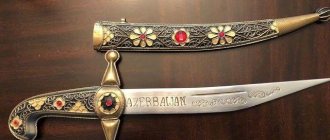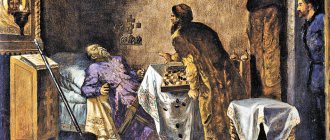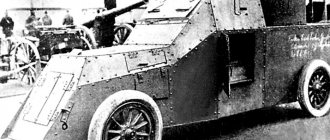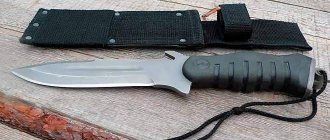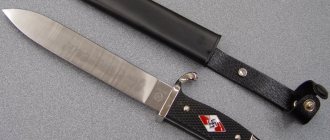Nowadays, the combat knives in service with the special services bear little resemblance to their historical counterparts. For example, in Russia the most famous combat knife today is the bayonet for the Kalashnikov assault rifle. If you ask people on the street to remember any other famous blades used in the army, then some might name a straight Caucasian dagger. But you can be sure that its name will be remembered only in the Caucasus or Cossacks.
Today we will tell you about another combat dagger - the bebuta. Before the revolution, this curved blade was very common in the tsarist army, but then they forgot about it. It remained a relic of past times, stopping its development immediately after the revolution.
Origin of the dagger
Since ancient times, curved blades have been preferred in the East. The traditional Caucasian dagger bebut was no exception. The name of the bebut knife comes from the Turkic word, which means thigh. It is very difficult to say when the history of the dagger began.
The blade became widespread at the beginning of the 20th century, when it became part of the weapons of the Russian army. It can be assumed that the ancestor of the dagger is a curved Persian or Ottoman knife. At the end of the 19th century, bebut was popular among the Cossacks.
Many people had flat daggers, but the plastuns preferred a curved blade. The thin and long blade ensured the convenience of carrying edged weapons in any situation.
Since 1840, the bebut was part of the uniform of the Kuban Cossacks.
But in fact, the history of the blade is much older. But any curved daggers with a curved blade at the end were called bebut. Today the name of the knife is associated with the product of the 1907 model.
Where did such weapons come from?
Curved blades usually came to Russia from the East. Bebut is an oriental type dagger with a long blade curved closer to the tip. The name of the dagger comes from the word “bek”, which means “thigh” in the Turkic language. For the first time, these weapons “lit up” in the Caucasus, since local residents traditionally had close ties with the Ottoman Empire and the entire East.
The mountaineers quickly appreciated the advantages of the curved bebut, which could be used to cut effectively in confined spaces or crowds. Soon the Russian officers realized that they were making very effective weapons. The mountaineers quickly noticed that the Russian soldiers did not have blades and skillfully used this. They put on chain mail and, having dispersed their horse, crashed into Russian soldiers armed with rifles. In the crowd, a mountaineer dismounted and began to chop with a bebut. Soldiers in close quarters could not be shot or stabbed with bayonets, so brave warriors often retreated after the battle unharmed, leaving behind several corpses and a bunch of wounded.
You should not think that the bebut attracted the attention of all military officials in Russia, but many used it, from the Cossacks to the artillerymen. Therefore, the high command decided that the curved dagger was worthy of becoming the official edged weapon of the Russian army.
Bebut in the Russian army
The dagger bebut.
In 1907, Bebut joined the Russian army. To replace the artillery bomb, another weapon was needed. The shape of the bebuta is much more convenient and it turned out that it can be used perfectly.
At first, only the highest ranks were armed with such a blade.
And starting from 1909, artillery bebut became available to everyone. Even despite the lack of a tradition of using daggers in the Russian army, the curved knife quickly became an indispensable part of the weapon. The first thoughts about arming the bebut appeared in 1902.
The commission voted almost unanimously in favor of the dagger. They considered the blade a good replacement for the checker. The artillerymen were not very good at wielding sabers. And the bebut was easy to use, and the main component was the convenience of the product.
The blade did not interfere with loading the guns. But today it is difficult for historians to say why in 1907 the choice fell on a curved blade. There was an alternative option, to arm the soldiers with cutlasses or axes, but it was the bebut that was approved.
Bebut
Bebut 1912. 136 Taganrog Infantry Regiment.
Let’s not argue: the Ka-bar is an excellent knife, which has been proving for decades that it occupies a leading place among the world’s elite of survival knives. He's not the only one.
But there was one knife in the history of Russia that was more widespread than all large knives combined. Unfairly forgotten and stopped in development. The first knife officially adopted for service by Russian special forces.
Caucasian dagger bebut
Bebut is a type of Persian double-edged dagger with a curved blade about 50 centimeters long without a guard. Unlike a straight dagger, the “kama” was moved to the hip when mounted on a horse. There is an opinion that it was from the method of wearing that it got its name (“bek” in Turkic: leg, thigh). Bebut and Kama came to Russia through the Caucasus, where they became widespread and became national weapons.
Naturally, Caucasian daggers also appeared in the Russian troops, first as trophies, then as a completely convenient universal blade.
Crooked daggers have come to Russia before, bypassing the Caucasus along Central Asian trade routes. But they were viewed more as objects of art. Richly decorated with carvings, gold, and precious stones, daggers could not fall into the hands of the military and become completely everyday melee weapons.
Cossack with bebut
No one claims that Bebut directly won the minds of the absolute majority of the Russian military. But it was he who received the widest distribution in all types of troops of the Russian Empire. It was used by Cossacks, hussars, infantrymen and even sailors. Yes, even sailors.
Alexey Nikolaevich Tolstoy in the work “Gloomy Morning” (June 22, 1941) (3rd book of “Walking in Torment”) gives bebuts into the hands of sailors: “...Latugin, naked to the waist, screamed hoarsely, was the first to rush with a crooked dagger - bebut and thrust he was wearing a black Cossack beshmet under his inlaid belt... Zaduyviter fell under the horse, with annoyance tore open his belly and, before the rider had time to slide to the ground, he hit him with his bebut ..."
In 1907, by order No. 287 of the Military Department, the bebut (a curved soldier's dagger of the 1907 model) was adopted by the Russian army.
The adoption of the bebut into service by the lower ranks of the artillery was caused by the arrival of new rapid-fire guns into the army in 1902. The work intensity of the personnel operating the gun increased significantly, and the authorized artillery piece did not allow for quick actions.
The need for its adoption was due to the fact that - with an increase in the rate of fire of the guns, the saber increasingly interfered with the artillery ranks in rapid movements at the guns. - the saber often caused accidents in the horse artillery, falling into the wheels of the guns, since the ranks of the horse artillery were forced to constantly dismount and sit on horseback. - it was impossible to leave numbers without weapons at all - the soldier must have psychological confidence that he is armed.
The commission of the Main Artillery Directorate, considering the issue of rearmament of artillerymen, issued a unanimous conclusion that the artillery bomb was unsatisfactory. 25 out of 30 people supported the introduction of the dagger. The main arguments against the dagger were: - the lack of a tradition of owning daggers in the Russian army (except for the Caucasus), - the limited combat capabilities of the dagger, - the lack of functions of an entrenching tool.
As an alternative to the bebut, a shortened cleaver with a saw on the butt or an ax were offered. As a result, the bebut was chosen - both as a short enough weapon so as not to lead to accidental losses from getting hit by wheels, and as a weapon that can be quite confidently used in chopping, i.e. possessing real fighting qualities.
In 1907, checkers were replaced with bebut for all gendarmes except sergeants. Since 1908, the bebut has been in service with junior ranks of machine gun teams. In 1909, by order of the Military Department No. 187 of May 17 (4 old style), bebut replaced checkers for all lower ranks of artillery troops, except for horse and horse-mountain artillery, sergeants and fireworks in field foot, mountain and park artillery and trumpeters in departments of foot artillery, cavalry regimental reconnaissance of the imperial army. In 1910, it was adopted by the lower ranks of mounted reconnaissance infantry regiments.
Since 1910, bebuts were again replaced by checkers among the lower ranks of the gendarmes.
But the Cossacks did not officially receive a uniform bebut. But the Cossacks are a different story altogether.
The officer bebut also did not appear, although it was among cavalry officers that the bebut became especially popular during the Kakvkazian War. Officers bought daggers with their own money, mostly of Persian origin. Richly decorated daggers, of course, were not used when cutting down trees, but they often found a place as an additional blade during battle.
On foot, the bebut was worn on the belt on the left near the belt buckle, and on horseback, it was moved to the left side.
The main purpose of the bebut is to serve as a replacement for the checker, where its use is limited by cramped conditions. Its length made it possible to confidently use the dagger when chopping. The slight curvature did not interfere with piercing actions. The double-edged nature of the blade and the symmetry of the handle made it possible to perform cutting and secting actions with different grips. The Bebut was officially in service until the 1917 revolution, but was actually used much longer. So, for example, the bebut was in service with foot police officers (revolutionary guards) from August 13, 1918, by decision of the congress of heads of external security departments of the KVD KSSO (mounted officers were armed with a saber).
Lev Abramovich Kassil in his work “My Dear Boys” (1944) writes that these same boys slaughtered the fascists with “sea knives - bebuts.” There is an opinion that the author meant a cadet broadsword, which has nothing to do with the bebut. In the Navy, the wearing of broadswords by cadets of higher naval schools was introduced on January 1, 1940, i.e. just before the war. But it is simply impossible to confuse a meter-long straight broadsword and a half-meter bebut.
3rd year naval school cadet with a broadsword
Igor Georgievich Shtokman in his work “Yards” describes a picture he saw in childhood: “...But over him, this officer, our sailor, the Marine Corps, was already hanging over him, raising his hand with a “bebut” cleaver. The cap's ribbons, their ends are in the teeth, the vest is visible through the black uniform open on the wide chest, and the sailor's cleaver is about to plunge into the throat of the enemy. Before the fascist has time to reach his “parabellum”, the khan will be his!..” Again the bebut is associated with sailors.
The left photo shows a motorist. They were also armed with bebuts.
Characteristics of the Bebut model 1907
The blade is steel, slightly curved, with two narrow fullers on each side. The handle is figured, narrow in the middle part. Installation of the handle: wooden cheeks, painted black, riveted with two brass rivets. The top rivet also holds the brass bushing in place. The scabbard is wooden, covered with leather, with a metal device. The device consists of a mouth, a bracket with a ring for a cord, on which the dagger is suspended from the waist belt, and a tip (toe) ending in a ball. The number of the military unit was stamped on the scabbard and hilt.
Curved soldier's dagger (bebut) model 1907 Country of origin Russia Total length, mm up to 600 Blade length, mm about 440 Blade width, mm 35 Weight, g up to 750
They were produced at various factories and weapons factories. Artinsky, Izhevsky and Zlatoust editions of bebuts are found in collections to this day. The rarest are the Artinsky bebuts.
Artinsky plant stamp
There were no decorations for the soldier's bebut. In 1912, the design was changed - clips appeared on the hilt, and military markings were already placed on them.
Early, before 1912, soldier's bebuts
and later.
You will laugh, but the famous Latvian riflemen also armed themselves with soldiers’ bebuts.
Today it is quite possible to purchase a soldier's bebut produced by the leading knife factories of modern Russia.
Plastun knife and bebut of the Don Arms Factory
They produce bebut Kizlyar no worse.
And now about the sad thing. In pursuit of pseudo-historicity, knife factories stopped developing the bebut as a universal blade used for both cutting and chopping. The same wooden plates on the handle do not make the grip comfortable. Over the past 20 years of Russian development, it would be possible to come up with a comfortable handle and test it in the forest. A good modern survival knife could work. The Plastunsky knife, created on historical grounds, especially loved by modern Cossacks, is really convenient, cuts well, but is too small for cutting branches.
Thank you
- Comments (2)
Comments
Faviz 2015-11-16 09:13 Guys, I need help, I have a bebut blade from 1917.
Zlatoust with a broken hilt, alas, I got it like this from my grandfather, my father was tricky with it in his own way, but I decided to restore it as it is and should be, and for this reason we need at least the approximate dimensions of the hilt and scabbard waffen 2015-11-16 10:55 It’s a bit small, but you can roughly understand it. Well, here you can also look through the forum https://forum.guns.ru/forummessage/122/201812-2.html
Update list of comments RSS feed of comments for this entry
Comments can be posted only by registered users.
JComments
Blade design
Bebut has in its structure something between a sword and a dagger. The length of the product was similar to the Scythian akanak or Roman gladius, which are considered swords. The product has a slightly curved blade up to half a meter and two fingers wide.
There are valleys on both sides. The mass of a standard bebut of the 1907 model reached 750 grams. The handle has a shape traditional for Caucasian weapons - a developed pommel and a good front stop. But the guard protecting the fingers on the blade was missing.
Examples of bebut dagger.
Combat use
An interesting point is that the bebeut was not initially considered as a weapon for combat. He had limited combat capabilities. It is also very inconvenient to dig with such a dagger. It’s just that certain types of troops required edged weapons.
Just to have it. But the checker was a serious hindrance for the artillerymen. There were cases when a long blade, dangling in a sheath on a belt, fell into the wheel of a cannon that was being pushed by soldiers. And the fighter could be seriously injured, even to the point of disability.
The artillerymen were not particularly taught how to wield a saber.
The tasks of the fighters of this unit are completely different. At that time, few people knew that the bebut would be more useful than the machine gun itself. Among the Cossacks, daggers were quite rare; they mostly used a straight blade - kama.
The bebut was used very often on the battlefield as a personal weapon. This product, as it turns out, can perform excellently in combat. The blade of the dagger was perfectly balanced and was suitable for striking or thrusting. They could also cut well.
In experienced hands, the product became a fast weapon. It can be used with a forward or reverse grip. It was these qualities that proved important during the First World War. The Bebut became the favorite weapon of the Plastun Cossacks. It was a kind of sabotage group.
Modern replicas of the product.
Sale of military antiques
The sale of antiques dating back to the period of World War II traditionally attracts a wide range of buyers. You can buy such goods from private collectors, as well as from those involved in military archaeology. If you are interested in the opportunity to buy military antiques in Moscow, then here, in addition to individual sellers, there are specialized stores that are happy to offer you items related to the front and rear of the Great Patriotic War.
Military antiques: online store Antik1941.ru
Our antique store is located in Moscow.
Antik1941.ru was founded in 2004 and today is a large specialized platform for the sale of antique items from the Second World War, World War I, and the Vietnam War. Many years of experience in the specialized market and extensive connections have allowed our store to form one of the most extensive collections of military antiques, the diversity of which we are in a hurry to present to Antik1941.ru clients. For anyone interested in antiques, the online store Antik1941.ru offers the following types of goods:
· weapons of the Second World War, as well as other military campaigns mentioned above; · military uniform of the Red Army, the Wehrmacht and other warring parties; · items of soldier's and officer's life: equipment, ammunition, dishes, personal belongings and much more; · awards: a large selection of Orders and Medals.
Antik1941.ru including a numismatic online store: we offer ancient and rare coins, banknotes, bonds.
About our products and the work of the store
All items and weapons that our online store offers are genuine, which is guaranteed by many years of experience and our authority among customers. The products contained in the Antik1941.ru catalog correspond to their descriptions, the results of which are available to customers. At the same time, the prices in our store are some of the best on the market. Delivery of purchased military antiques is carried out by courier in Moscow, as well as to the regions of Russia using postal services. You can find out more about any of the products presented, as well as find out more about delivery options by calling the numbers listed on the website.
Our online resource is an excellent find for professional antique dealers, collectors and history buffs. Often those who want to make an original gift come to us. The trade in military antiques has become increasingly popular in recent years, and the desire for great moments and mysteries of history is increasingly disturbing the hearts of our compatriots. Many agree that nothing can bring a person closer to an era better than things from seemingly forgotten times. With the help of antiques, the war and its way of life become accessible not only from the point of view of harsh front-line chronicles, but also through clear examples, which are the exhibits that our antiques store presents.
On non-involvement in Nazi propaganda
It was Antik1941.ru that assembled an amazing collection of military antiques, which is regularly updated with new arrivals. The most extensive collections are paraphernalia and objects of the workers' and peasants' Red Army and the Third Reich. Numerous things that belonged to the German army and its soldiers quite often have fascist symbols applied to them. We hasten to assure that the sale of such items should in no way be associated by our customers with the propaganda of a prohibited ideology. It’s all about the historical authenticity of the collection and the desire to present history from its true position.
Bebut model 1907
The artillery bebut of the 1907 model is 60 cm long. The length of the blade itself is 440 mm. The curved shape of the dagger is distinguished by smooth lines; the blade has fullers that lighten the weight of the structure. The handle was shaped with shiny overlays.
The fastening elements of the handle are made of brass. The wooden scabbard was fastened with metal inserts. The weight of the product was approximately 750 grams. The product, which was intended for junior staff, did not have decorative elements.
Bebut was produced at three factories - Izhevsk, Artinsky and Zlatoust. The product lasted in the army until the revolution. But some Red Army soldiers adopted this dagger, as evidenced by numerous photographs.
In capable hands it was an excellent product. The blade had a double-sided sharpening and its width was 35 mm. The curved shape and long length made it possible to deliver crushing slashing blows. In accordance with the regulations, the dagger was worn on the left side.
Bebuta daggers of the 1907 model.
What can you say about Bebuta?
The impact force with such a weight is very serious, although the handle seems too thin, it fits perfectly in the palm. You can deliver piercing blows with a dagger; a slight curvature does not interfere with this at all. The blade is heavier than a straight kama, so the chopping blows are much stronger, which is also facilitated by the curved shape.
The only negative is that the bebut is a bladed weapon, which means you cannot carry it, and it will be problematic to buy. On the other hand, no one forbids purchasing unsharpened models that you can carry with you. If you really want to, you can sharpen it, only then can it be equated to making chemical weapons, but who will know about this? Keeping even a sharpened dagger at home is not illegal.
It is a pity that they did not revive the bebut in the 21st century in the same way as they did with the Cossack Plastun knife. It could have been modified a little, designed as a household item, like a machete. I'm sure it would beat out the big survival knives in the knife markets.
Gendarmes and machine gunners
After the decision was made in 1902 to arm artillerymen with a curved blade, quite a lot of time passed. The bureaucratic machine moved very hard in those days. In 1907, according to an imperial decree, they began to arm the lower ranks of the gendarmerie.
The exceptions were sergeants and trumpeters. In 1908, they began to arm machine gunners with a dagger, for whom the convenience of edged weapons played an important role.
And only in 1909 the product reached the artillerymen.
In official documents, the name – bebut – was not indicated anywhere; only “crooked dagger” appeared. Cossacks were never officially allowed to carry these weapons. But in the Cossack army, they carried various weapons.
Bebut today
You shouldn't wait for the dagger to be revived. In the 21st century, such products are purchased for personal collections. Today, stores sell a lot of replicas of the Bebut model from 1907. Externally, the product completely replicates the blade of those times.
But to purchase you will need a license to carry and store bladed weapons. You can find products from the category of works of weaponry art. The sheath is made from valuable wood species. And the daggers themselves are decorated with various decor.
Bebut dagger in a modern design.

